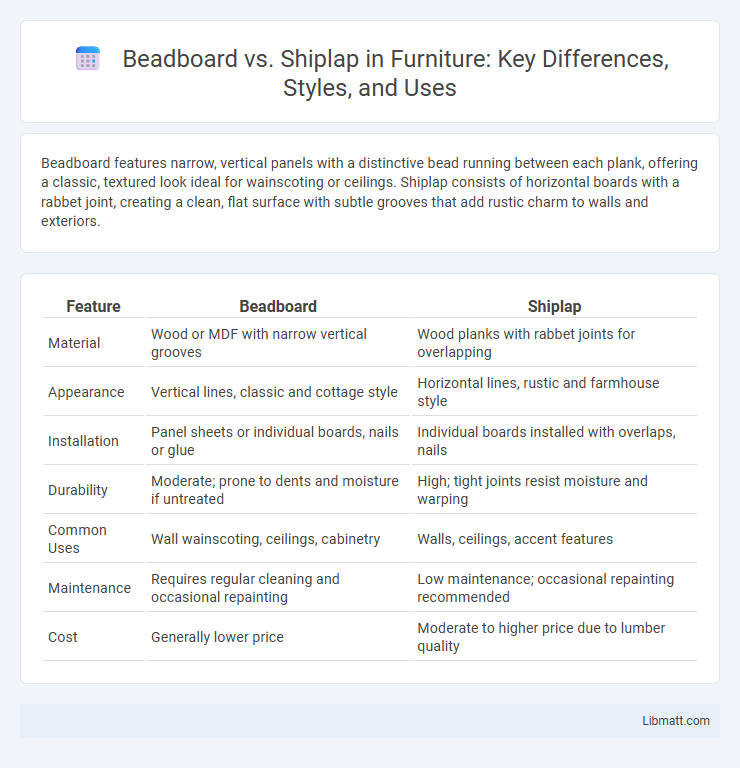Beadboard features narrow, vertical panels with a distinctive bead running between each plank, offering a classic, textured look ideal for wainscoting or ceilings. Shiplap consists of horizontal boards with a rabbet joint, creating a clean, flat surface with subtle grooves that add rustic charm to walls and exteriors.
Table of Comparison
| Feature | Beadboard | Shiplap |
|---|---|---|
| Material | Wood or MDF with narrow vertical grooves | Wood planks with rabbet joints for overlapping |
| Appearance | Vertical lines, classic and cottage style | Horizontal lines, rustic and farmhouse style |
| Installation | Panel sheets or individual boards, nails or glue | Individual boards installed with overlaps, nails |
| Durability | Moderate; prone to dents and moisture if untreated | High; tight joints resist moisture and warping |
| Common Uses | Wall wainscoting, ceilings, cabinetry | Walls, ceilings, accent features |
| Maintenance | Requires regular cleaning and occasional repainting | Low maintenance; occasional repainting recommended |
| Cost | Generally lower price | Moderate to higher price due to lumber quality |
Introduction to Beadboard and Shiplap
Beadboard consists of narrow, vertical planks with distinctive bead-like grooves, commonly used to add texture and a classic cottage feel to walls or ceilings. Shiplap features horizontal wooden boards with rabbeted edges that overlap to create a tight, weatherproof seal, often associated with farmhouse and coastal interior designs. Both materials enhance interior spaces with unique textures while serving functional purposes in wall treatments.
Understanding Beadboard: Key Features
Beadboard consists of narrow wooden planks with distinctive vertical grooves, typically 1/4 inch wide, creating a textured, classic look ideal for wainscoting or ceilings. Its tongue-and-groove design ensures easy installation and a seamless appearance, often painted white to enhance brightness and charm in interior spaces. Beadboard's durability and moisture resistance make it a popular choice for bathrooms, kitchens, and cottage-style decor.
Exploring Shiplap: Essential Characteristics
Shiplap features overlapping horizontal boards with a rabbet joint that creates a distinctive shadow line, providing both durability and a sleek, rustic aesthetic. Its water-resistant design makes it ideal for interior accent walls and exterior siding, blending farmhouse charm with modern appeal. You can enhance your space by choosing shiplap for a clean, structured look that adds texture without overwhelming your decor.
Visual Differences Between Beadboard and Shiplap
Beadboard features narrow, vertical planks with distinctive grooves or beads running along each panel, creating a textured, classic cottage-style appearance. Shiplap consists of wider, horizontally installed boards with a rabbeted edge that produces a clean, tight seam and a more modern, sleek line. The visual contrast lies in beadboard's repetitive, narrow ridges versus shiplap's flat, broad planks and shadow lines.
Installation Process: Beadboard vs Shiplap
Beadboard installation involves aligning narrow, vertical panels with tongue-and-groove edges for a seamless fit, often requiring careful nailing into studs and precise cutting around corners. Shiplap installation consists of horizontal planks with rabbeted edges that overlap, creating a tight seal and a characteristic shadow line, typically secured with nails or adhesives directly to wall studs or furring strips. Understanding these differing techniques helps you choose the right method for your project's desired aesthetic and ease of installation.
Durability and Maintenance Comparison
Beadboard offers moderate durability with resistance to moisture when properly sealed, making it suitable for wainscoting and bathroom applications, while shiplap provides higher durability due to its thicker, overlapping boards that better withstand structural movement and weather exposure. Maintenance for beadboard typically involves regular repainting or sealing to prevent moisture damage and warping, whereas shiplap requires less frequent upkeep, with periodic cleaning and occasional repainting to maintain its protective finish. Both materials benefit from proper installation and moisture barriers to enhance longevity and reduce maintenance needs in high-humidity environments.
Design Styles Best Suited for Beadboard
Beadboard is best suited for classic, cottage, and farmhouse design styles due to its vertical grooves that add texture and charm. It complements traditional and coastal interiors by providing a warm, inviting atmosphere often seen in wainscoting or ceilings. This paneling enhances spaces with vintage or rustic aesthetics, making it ideal for kitchens, bathrooms, and informal living areas.
Design Styles Best Suited for Shiplap
Shiplap is best suited for farmhouse, coastal, and modern rustic design styles due to its clean lines and horizontal plank layout that adds texture without overwhelming the space. Its smooth, uniform appearance complements minimalist and Scandinavian interiors, enhancing a sense of openness and simplicity. Incorporate shiplap in your home to achieve a timeless, versatile backdrop that aligns with both casual and sophisticated aesthetics.
Cost Differences: Beadboard vs Shiplap
Beadboard typically costs between $1 to $3 per square foot, offering a budget-friendly option for wall paneling compared to shiplap, which ranges from $3 to $7 per square foot due to its wider planks and more intricate installation. Installation costs for beadboard are generally lower since it often uses narrower panels and simpler attachment methods, while shiplap may require precise alignment and more labor time. Overall, beadboard provides an economical choice for decorative walls, whereas shiplap reflects a higher investment aligned with its rustic, farmhouse aesthetic.
Choosing the Right Wall Treatment for Your Space
Beadboard offers a classic, textured look with narrow vertical planks that complement traditional and cottage-style interiors, while shiplap features wider, horizontal boards with a distinctive groove that suits modern farmhouse and coastal designs. Your choice depends on the room's aesthetic and function: beadboard creates a cozy, detailed feel ideal for wainscoting or smaller areas, whereas shiplap provides a sleek, continuous surface perfect for accent walls or open spaces. Consider factors like moisture resistance, installation complexity, and the desired visual impact to select the optimal wall treatment for your space.
Beadboard vs shiplap Infographic

 libmatt.com
libmatt.com